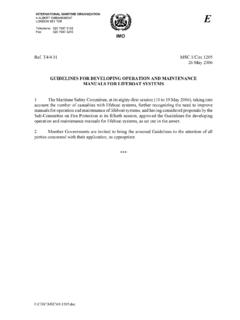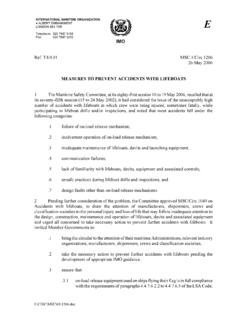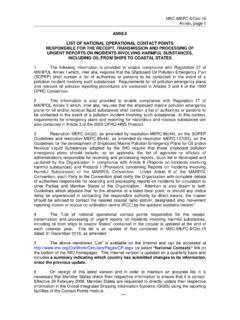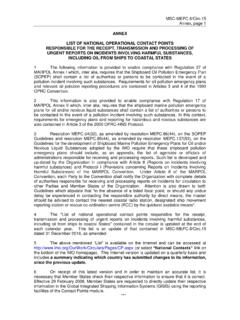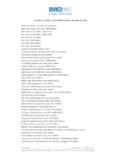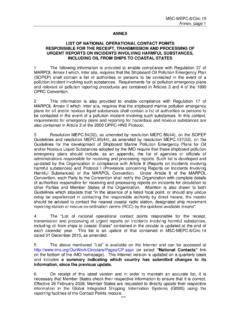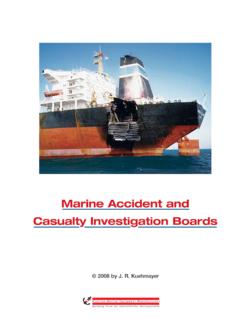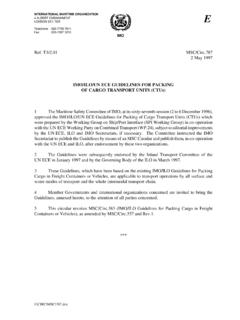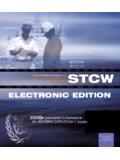Transcription of INTERNATIONAL MARITIME ORGANIZATION 4 …
1 I:\CIRC\MSC\ INTERNATIONAL MARITIME ORGANIZATION 4 albert embankment london SE1 7SR Telephone: 020 7735 7611 Fax: 020 7587 3210 Telex: 23588 IMOLDN G IMO E Ref. T2 12 June 2001 GUIDANCE ON FATIGUE MITIGATION AND MANAGEMENT 1 The MARITIME Safety Committee (MSC), at its seventy-first session (19 to 28 May 1999), considered the issue of human fatigue and the direction where IMO efforts should be focused. In this regard, it was agreed that practical guidance should be developed to provide appropriate information on fatigue to all parties concerned. This guidance should inform each party that has a direct impact on vessel safety (naval architects, owners/operators, masters, officers, ratings, training institutions, etc.) of the nature of fatigue, its causes, preventive measures and countermeasures. 2 Accordingly, the MSC, at its seventy-fourth session (30 May to 8 June 2001), approved the annexed guidelines, composed of self-contained Modules, each addressing a different party.
2 The Modules have been assembled using existing information, in a useful format, for transmission to the different parties who have a direct impact on vessel safety. 3 Member Governments are invited to: .1 bring the attached guidelines to the attention of their MARITIME Administrations and relevant industry organizations and to all other parties who have direct impact on ship safety; .2 use this guidance as a basis for developing various types of tools for dissemination of the information given in the guidelines (such as: pamphlets, video training modules, seminars and workshops, etc.); and .3 take the guidelines into consideration when determining minimum safe manning. 4 Shipowners, ship operators and shipping companies are strongly urged to take the issue of fatigue into account when developing, implementing and improving safety management systems under the ISM Code.
3 ** I:\CIRC\MSC\ ANNEX GUIDELINES ON FATIGUE INTRODUCTION Foreword Fatigue can be defined in many ways. However, it is generally described as a state of feeling tired, weary, or sleepy that results from prolonged mental or physical work, extended periods of anxiety, exposure to harsh environments, or loss of sleep. The result of fatigue is impaired performance and diminished alertness. The effects of fatigue are particularly dangerous in the shipping industry. The technical and specialized nature of this industry requires constant alertness and intense concentration from its workers. Fatigue is also dangerous because it affects everyone regardless of skill, knowledge and training. Effectively dealing with fatigue in the marine environment requires a holistic approach. There is no one-system approach to addressing fatigue, but there are certain principles ( lifestyle habits, rest, medication, workload.)
4 That must be addressed in order to gain the knowledge and the understanding to manage this human element issue. OBJECTIVE The human element, in particular fatigue, is widely perceived as a contributing factor in marine casualties. The Exxon Valdez, one of the worst MARITIME environmental disasters in the last century, is one of the many mishaps where fatigue was identified as a contributing factor. To assist in the development of a marine safety culture by addressing the issue of fatigue, the INTERNATIONAL MARITIME ORGANIZATION (IMO) has developed practical guidance to assist interested parties to better understand and manage the issue of fatigue. The philosophy behind the development of the guidance was not to develop new information but rather assemble what already exists, in a useful format, for transmission to those parties who have a direct impact on ship safety.
5 The outline of the information is related to the potential dangers associated with fatigue and ultimately the effect on the health and safety of the personnel working on ships. The guidelines contain information on the symptoms and causes of fatigue, and address solutions to combat fatigue to improve the associated health problems and help prevent a fatigue related accident from occurring. ORGANIZATION The guidelines are composed of Modules each devoted to an interested party. The modules are as follow: ANNEX Page 2 I:\CIRC\MSC\ 1. Module 1 Fatigue 2. Module 2 Fatigue and the Rating 3. Module 3 Fatigue and the Ship s Officer 4. Module 4 Fatigue and the Master 5. Module 5 Fatigue and the Training Institution and Management Personnel in charge of Training 6. Module 6 Shipboard Fatigue and the Owner/Operator/Manager 7.
6 Module 7 Shipboard Fatigue and the Naval Architect 8. Module 8 Fatigue and the MARITIME Pilot 9. Module 9 Fatigue and Tugboat Personnel 6. Appendix Fatigue related documentation HOW TO USE THESE MODULES Although all Modules are self-contained, it is recommended that all parties become familiar with Module 1, which contains general information on fatigue. In other instances it will be beneficial if the reader (interested party) becomes familiar with Modules other than the immediately applicable one. It is strongly suggested that maximum benefit will be derived from the integration of this material into: Safety management systems under the ISM Code; Training courses, particularly management oriented courses; Accident investigation processes and methodologies and; Manning determinations. FUTURE WORK These Guidelines are a living document; they should be updated periodically as research reveals new information and new methods are uncovered to deal with the issue of fatigue.
7 Further, the present structure self-contained Modules allows for the creation of new Modules directed to other interested parties. ANNEX Page 3 I:\CIRC\MSC\ Guidelines on Fatigue Module 1 FATIGUE Foreword The Guidelines on Fatigue contain practical information that can assist interested parties (Naval Architects/Ship designers, owners/operators, Masters, Officers, other crew members and training institutions) to better understand and manage fatigue. The guidelines provide information on the potential dangers of fatigue and ultimately the effect on the health and safety of the personnel working on ships. The guidelines contain information on the symptoms and causes of fatigue, and address solutions to combat fatigue in order to reduce associated health problems and prevent fatigue-related accidents from occurring.
8 The guidelines have been divided into nine modules, as follows: 1. Module 1 Fatigue 2. Module 2 Fatigue and the Rating 3. Module 3 Fatigue and the Ship s Officer 4. Module 4 Fatigue and the Master 5. Module 5 Fatigue and the Training Institution and Management Personnel in charge of Training 6. Module 6 Shipboard Fatigue and the Owner/Operator/Manager 7. Module 7 Shipboard Fatigue and the Naval Architect/Ship Designer 8. Module 8 Fatigue and the MARITIME Pilot 9. Module 9 Fatigue and Tugboat Personnel 10. Appendix Fatigue related documentation It is recommended that all parties become familiar with Module 1 prior to using Modules 2 9. Module 1 (Fatigue) contains general information on the subject of fatigue definitions, causes, effects, etc. ANNEX Page 4 I:\CIRC\MSC\ Guidelines on Fatigue Module 1 FATIGUE 1.
9 INTRODUCTION For many years, fatigue was discounted as a potential cause of or contributor to human error. One reason for this misunderstanding was the old myth that fatigue could be prevented by various characteristics: personality, intelligence, education, training, skills, compensation, motivation, physical size, strength, attractiveness, or professionalism. However, recent accident data and research point to fatigue as a cause of and/or contributor to human error precisely because of its impact on performance. Human error resulting from fatigue is now widely perceived as the cause of numerous marine casualties, including one of the the worst MARITIME environmental disasters in the last century, the Exxon Valdez. The negative effects of fatigue present a disastrous risk to the safety of human life, damage to the environment, and property.
10 Because shipping is a very technical and specialized industry, these negative effects are exponentially increased, thereby requiring seafarers constant alertness and intense concentration. This module provides a general overview of fatigue, its causes, and its potential effects on MARITIME personnel. The key issue addressed within this module is that fatigue is a fundamental problem for the MARITIME industry as it detrimentally affects performance at work. 2. DEFINING FATIGUE There is no universally accepted technical definition for fatigue. However, common to all the definitions is degradation of human performance. The following definition is found in IMO s , List of Human Element Common terms: A reduction in physical and/or mental capability as the result of physical, mental or emotional exertion which may impair nearly all physical abilities including: strength; speed; reaction time; coordination; decision making; or balance.
